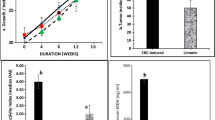Summary
Hydantoin reduced the incidence of urethane induced lung adenomas in SWR mice. This tumor protective effect might be attributed to the modifying effect of the drug on the immunological system of the treated mice.
Similar content being viewed by others
References
Burnet, F. M.: Immunological factors in the process of carcinogenesis. Brit. med. Bull. 20, 154 (1964)
Easton, J. D.: Potential hazards of hydantoin use. Ann. intern. Med., 77, 998 (1972)
Grob, P. J., Herold, G. E.: Immunological abnormalities and hydantoins. Brit. med. J. 1972 II 561
Sorrell, T. C., Forbes, I. J., Burness, F. R., Rischbieth, R. H. C.: Depression of immunological function in patients treated with phenytoin sodium (sodium diphenylhydantoin). Lancet 1971 II, 1233
Trainin, N., Linker-Israeli, M., Small, M., Boiato-Chen, L.: Enhancement of lung adenoma formation by neonatal thymectomy in mice treated with 7,12-Dimethylbenz (a) anthracene or urethane. Int. J. Cancer 2, 326 (1967)
Author information
Authors and Affiliations
Rights and permissions
About this article
Cite this article
Levo, Y. The protective effect of hydantoin treatment on carcinogenesis. Naunyn-Schmiedeberg's Arch. Pharmacol. 285, 29–30 (1974). https://doi.org/10.1007/BF00499526
Received:
Accepted:
Issue Date:
DOI: https://doi.org/10.1007/BF00499526




